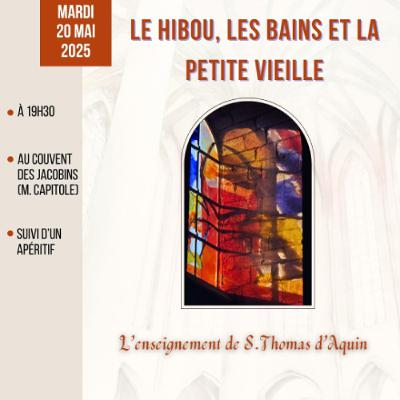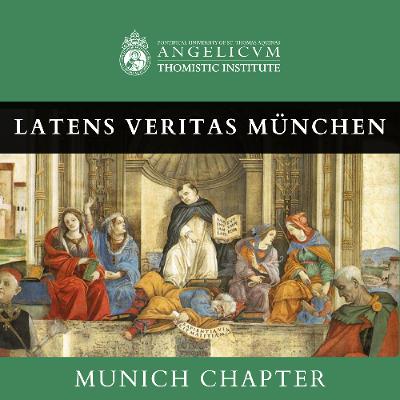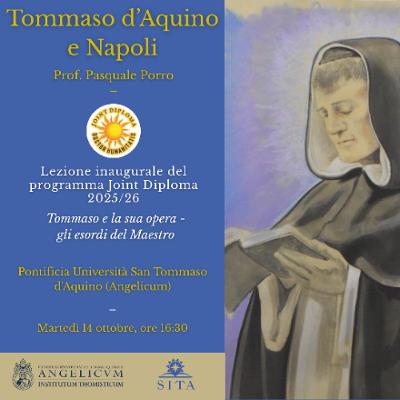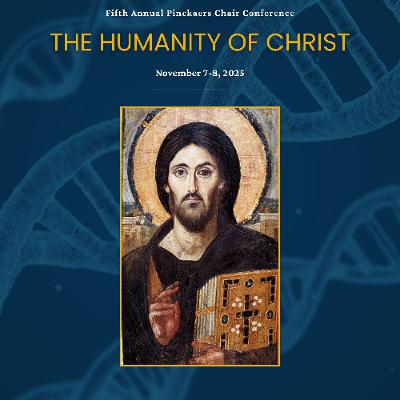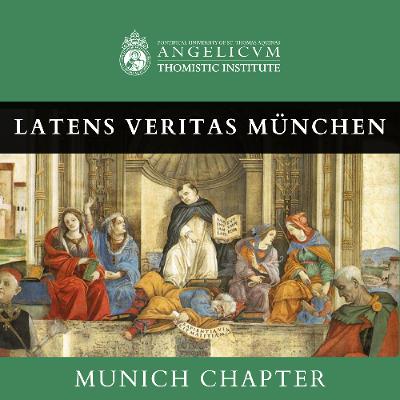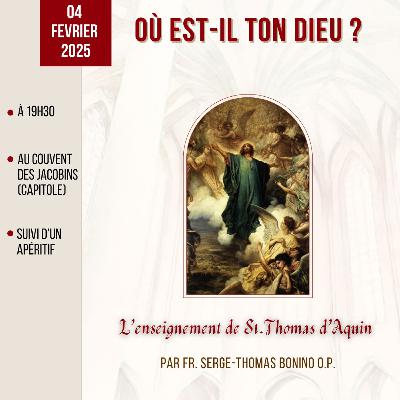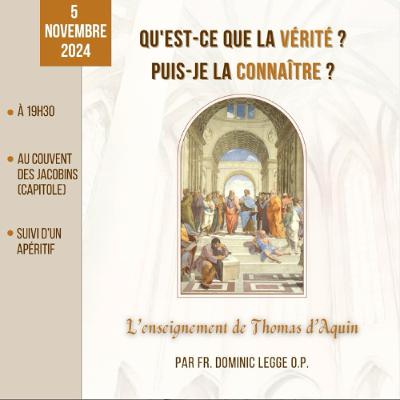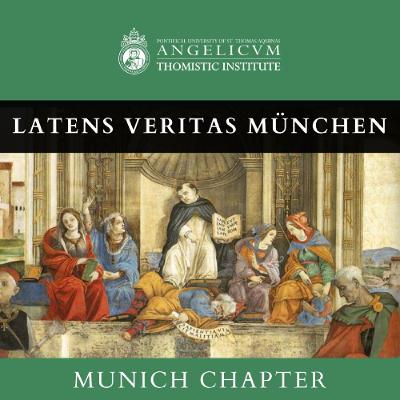Discover Angelicum Thomistic Institute
Angelicum Thomistic Institute

Angelicum Thomistic Institute
Author: Angelicum Thomistic Institute
Subscribed: 170Played: 3,936Subscribe
Share
© All rights reserved
Description
The Thomistic Institute Angelicum encourages the study of Thomas Aquinas and the Thomistic tradition as a living voice and inspiration for Catholic theology and philosophy. For more information about the Institute's programs or upcoming events please visit our website: https://angelicum.it/thomistic-institute/
478 Episodes
Reverse
Le Hibou, les Bains et la Petite Vieille | François-Xavier Putallaz by Angelicum Thomistic Institute
Thomas von Aquin und die Zehn Gebote | Ludger Schwienhorst-Schönberger by Angelicum Thomistic Institute
Ist Gottes Wesen für uns Unerkennbar? | Patrick Zoll SJ by Angelicum Thomistic Institute
Creation and Evolution: an Aristotelian-Thomistic Perspective | Mariusz Tabaczek OP by Angelicum Thomistic Institute
Lezione Inaugurale del Programma Joint Diploma 2025/26 | Prof. Pasquale Porro - Tommaso d'Aquino e Napoli
Why does the Vatican support an astronomical observatory? That question masks a deeper question: why does anyone choose to be a scientist? The motivation behind our choices, both as individuals and as a society, determines the questions we pursue and the kinds of answers that are found to be satisfying. It determines the kinds of answers that are found to be satisfying. And ultimately, it affects the way in which we think of ourselves.
Re-evaluating Penal Substitution and Vicarious Satisfaction
This talk addresses the central soteriological question: "Was Jesus Punished?" While it is undisputed that Jesus was punished by human authorities, this presentation argues against the proposition that He was punished by God. It critically examines the dominant theory of penal substitution (substitutio penalis) and advocates for a return to the classical model of vicarious satisfaction (satisfactio vicaria).
The presentation traces the problem’s origin to the post-Anselmian theological shift, which was radicalized by the Reformers into penal substitution. Extreme interpretations of this doctrine (e.g., L. Bourdaloue) portray God the Father as a "persecutor" discharging "divine hatred" onto His Son, creating a "toxic" image of a sadistic God while ignoring the Son's will.
Three strategies for resolving this impasse are analyzed, rejecting "finding depth in penal substitution", which introduces "darkness" into the image of God, and the concept of Stellvertretung as a dialectical evasion.
The preferred strategy is to restore the Anselmian distinction between involuntary punishment and voluntary satisfaction. The talk argues that Christ did not receive punishment but offered satisfaction. Defending this model biblically, it shows that "ransom" (lutron, Mk 10:45) is rooted in OT law (Ex 21:30) as a payment instead of punishment to avoid violence. It also refutes key penal substitution "proof texts": "made sin" (2 Cor 5:21) means "sin offering" (hattā’t); "became a curse" (Gal 3:13) means "cursed in the eyes of Israel"; and "bearing guilt" (Isa 53) signifies non-retaliation.
The talk also analyzes the position of St. Thomas Aquinas. It highlights that although Aquinas, unlike Anselm, uses the term "punishment" (poena) to describe Christ's act, he understands it as voluntarily accepted satisfaction. This is structurally distant from later penal substitution, as for Thomas: God's wrath is directed solely at sin, never at the Son, and Both act from supreme love; God the Father only permits the Passion (not positively willing it), which is the work of human freedom; and the formal, decisive element of salvation is love, not suffering itself. The talk concludes with a negative answer to the titular question, affirming a soteriology of love and voluntary satisfaction, not divine retributive punishment.
Every Sunday, Catholics pray in the Creed, "He ascended into heaven and is seated at the right hand of the Father." Patristic and medieval theologians felt they had a concrete grasp of where the "heaven" Christ ascended to actually was, but their answers are all based on very outdated views of the cosmos. Modern discussions of the Ascension sometimes shy away from the question, to the point of "spiritualizing" the event and downplaying the physicality of Christ's present state. In this talk I will argue, first, that attempts to "weaken" the physicality of Christ's glorified body threaten our understanding of the resurrection and salvation, in general, and of the Eucharist in particular. Then, I will then look at medieval theories of the place of Christ's Ascension and point out that while modern science makes those specific ideas untenable, it also offers tools to imagine a real "place" for Christ's Glorified Body.
Jesus Christ is not only truly God, but he is also truly human, the divine person of the Word in two natures, divine and human. This means that his true human nature is integral and complete, composed of an immaterial soul and a material body. While we believe as Catholics in the human reality of Jesus’ body, it is not a matter of faith that we confess certain facts about Jesus’ DNA, including the mere fact that his human body had and has DNA. Yet theology today has to grapple with the fact that Jesus had DNA, because we know since the discovery of the chemical’s full significance in the twentieth century, that DNA is a fundamental part of the life and genetic inheritance of earthly living things, ourselves, and Jesus, included. DNA testing by commercial companies is a way by which customers can have their DNA matched to relations and regional populations. This paper asks what would be the result of a DNA test taken by Jesus, with particular reference to the fact that Jesus had no biological father. It investigates the question of Jesus’ DNA from different theological perspectives, including the Thomistic tradition, and surveys possible solutions.
The Scriptures tell us that “Jesus increased in wisdom and in years, and in divine and human favor” (Lk 2:52). How are to interpret these inspired words in the context of the Church’s teaching on the hypostatic union confirmed at both Nicea and Chalcedonian?
This conference draws us into the teaching of theologians throughout the centuries who have struggled to properly interpret “two na¬tures, inconfusedly, unchangeably, indi¬vis¬i¬bly, insepara¬bly,” united in “one Person and one Subsistence”, such that “the property of each nature being pre¬served, and concur¬ring in one Person and one Subsis¬tence […] the same Son, and only begot¬ten, God the Word, the Lord Jesus Christ.”
Having these profound theological statements as a foundation, this paper addresses one seemingly simple question: whether or not Christ, in his human nature, made progress?
I will respond to the question by analyzing three specific aspects of Christ’s assumed nature: first, the question of physiological change and progress; second, progress as to Christ’s knowledge which will necessarily require distinctions as to his Divine and human knowledge; third, the question of whether Christ progressed in moral virtue. Since moral virtue perfects both the rational and sensitive appetite, one cannot avoid mention of Christ’s passions as movements of the latter appetite. This discussion, however, will be limited to a few key points pertinent to the specific question of progress.
[Sources, both ancient, medieval, and contemporary, abound, but Thomas Aquinas’s writings are key both for their abundance and specificity. His Christological teachings appear in many works, including De Veritate, De Virtutibus, and various Commentaries on the Scriptures, and fine nuggets are gleaned from these, but emphasis must be given to his comprehensive mature and subtle synthesis which appears in the Tertia pars of his Summa Theologiae, written shortly before his death. I also will make brief reference to the other Dominican Doctor of the Church, Catherine of Siena. Though not a systematic work, her Dialogue offers a profound Christology, particularly noteworthy in the doctrine of Christ as Il Ponte – the bridge between earth and heaven.]
Among the important mysteries of Christ’s life, few are as overlooked in theology as his walking on water, perhaps because this exceptional action seems to distance him from other human beings while not benefitting anyone. Our goal in this presentation is to remedy this oversight. It is structured according to several questions. What does walking on water mean? What does it not mean? What is the unique context of this event in Christ’s life? How did he walk on water? Why did he do so? How does this mystery save us?
Current exegetical scholarship allows us to grasp significant theological elements present in the pericopes dealing with this episode in Matthew, Mark and John. It is invariably placed in the context of Jesus’s prayer and after the miraculous feeding of the multitude. In Matthew it is a forerunner of the revelation of Christ’s true identity, in Mark it is a key stage in the development of the disciples’ faith in Jesus, while in John it is a sign like no other, that is, one that is not counted among the seven signs. Because in Sacred Scripture deeds manifest and confirm words, while words proclaim and clarify deeds, special attention will be afforded to the words uttered by Christ on this occasion.
Saint Thomas draws critically from Hugh of Saint Victor’s understanding of Jesus’s walking on water as a sign of a quality (dos) of the glorified body. As such it reveals different aspects of Christ’s being. Although it is not treated in the Tertia Pars, this action should be interpreted in light of what is said there of the other actions and experiences of the Savior. Once its soteriological fittingness is established, we determine and analyze the multiple ways in which this event saves us. These soteriological causalities prove that Jesus’s walking on water is among the most beneficial mysteries for our life of discipleship and mission.
This talk will offer an introduction to the principle that Christ is not a human "person" but is fully human. The first half of the talk will explore how this is expressed in the foundational Patristic writers (especially Cyril of Alexandria), and then the other half will explain why this principle is essential to understanding that salvation flows from Christ's humanity. Because Christ is the person of the Word (with his humanity) we are saved by union with the Word's humanity.
This talk examines the question of whether Jesus Christ possessed the theological virtue of faith and, if not, in what sense he can be called faithful. Drawing upon Scripture, and particularly the theology of St. Thomas Aquinas, it argues that while Christ did not have faith in the proper sense—since faith concerns truths not yet seen—he nevertheless embodied its perfection through the beatific vision granted to him from the first moment of his conception. Aquinas teaches that faith and the beatific vision are mutually exclusive: one either sees God’s essence directly, as in the vision of the blessed, or one believes in what is unseen. Because Christ, as the Incarnate Word, saw the Father immediately, he did not live by faith but by vision. Yet this vision was necessary for his role as the immovable and perfect principle of human salvation, the “author and finisher of faith” (Heb 12:2).
The study further explores the Pauline expression pistis Christou (“faith/faithfulness of Christ”) and argues that even if read as a subjective genitive, the phrase refers not to Christ’s personal act of believing but to his unwavering fidelity to the Father’s salvific will. Through his obedience “unto death, even death on a cross” (Phil 2:8), Christ merited the perfection of faith without sharing its defect of unseeing. Consequently, his beatific knowledge grounds his perfect charity, by which he redeemed humanity. Thus, while Christ did not have faith as a wayfarer does, he was supremely faithful—the exemplar and efficient cause of all faith. His fidelity, flowing from divine vision and perfect love, ensures the faith and salvation of those united to him.
Integral to Jesus's full humanity was his manhood or maleness. As the "exemplum virtutus," he thus imbibed all the virtues in a male-structured and male-conditioned manner. This includes the virtue of chastity (or, more specifically in his case, the virtue of virginity). Though men are neurobiologically oriented to sexual desire and pleasure and to the visual aspects of sex, to the extent that the male fallen condition is particularly prone to lust, the struggle with lust was not characteristic of Jesus, even if he possessed the natural male neurobiological structuring. The Gospel evidence shows a Jesus who enjoyed unfettered, virtuous relationships with his female (and male) disciples and who insisted that his followers exercise strict sexual self-mastery. He was the model for this. The Gospel evidence also indicates that Jesus held an extremely high estimation of marriage. Though he did not struggle with lust, he could however have experienced sexual temptation, given his recognition of the good of sex and the good of marriage. This talk will examine all of this.
Ethik des Krieges | Dr. Sebastian Ostritsch by Angelicum Thomistic Institute
Où est il ton Dieu | Serge-Thomas Bonino OP by Angelicum Thomistic Institute
Jesus Christ, un mythe vrai? | Anthony Giambrone OP by Angelicum Thomistic Institute
Qu'est ce qu'est la veritè? | Dominic Legge OP by Angelicum Thomistic Institute
Thomas von Aquin und die Frage nach der Heiligung Mariens | Riester by Angelicum Thomistic Institute
Aristotle Goes to Med School - Ancient Psychology and Modern Neuroscience | Dr. Daniel de Haan by Angelicum Thomistic Institute


